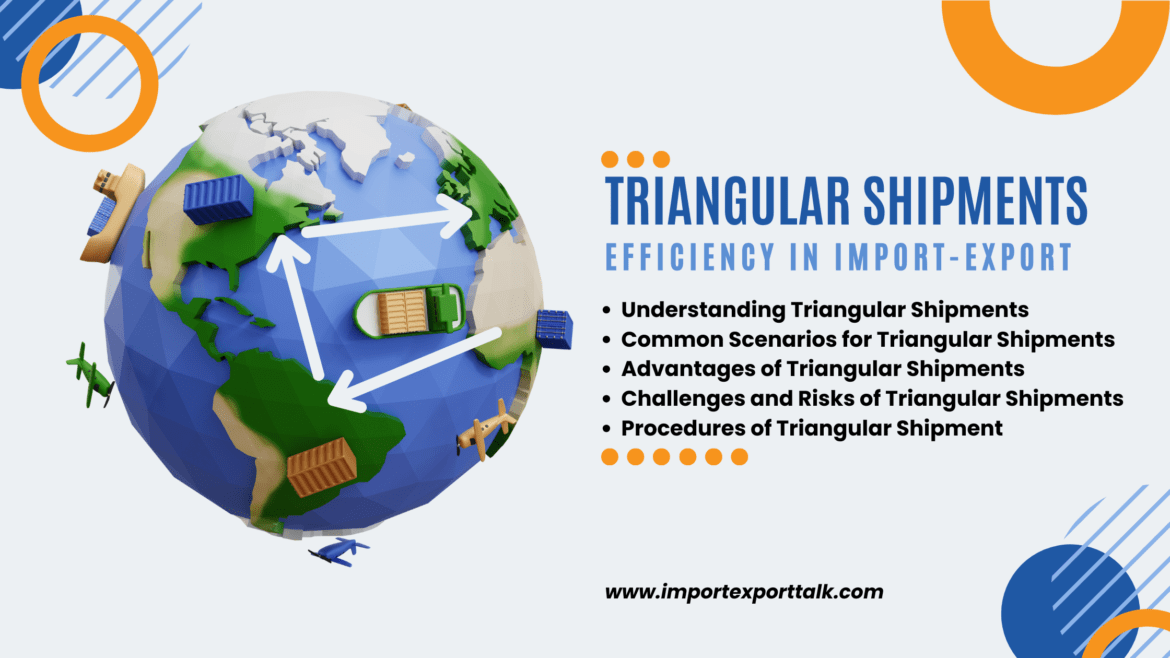In the interconnected world of international commerce, the efficiency of shipping and logistics plays a pivotal role in the success of global trade. Triangular shipments are a method that has gained prominence for its ability to streamline the movement of goods across borders.
The concept of triangular shipments, explore their significance in the realm of global trade, and understand the purpose behind discussing this fascinating topic.
What is Triangular Shipments?
Triangular shipments, often referred to as drop shipments or indirect shipments, are a logistical arrangement where a company in one country purchases goods from a supplier in a second country and ships them directly to a customer in a third country. In simpler terms, it’s a trade practice where goods don’t physically enter the buyer’s country. Instead, they move directly from the supplier’s country to the customer’s destination.
Triangular shipments can involve various parties, such as manufacturers, distributors, and retailers, and are known for their ability to reduce shipping costs and streamline supply chains. This innovative approach to trade has become increasingly popular due to its efficiency and the advantages it offers.
Understanding Triangular Shipments
Triangular shipments, often referred to as indirect shipments or third-party shipments, are a sophisticated logistics strategy employed in the world of global trade. These shipments involve a carefully orchestrated collaboration between three key entities: the buyer, the seller, and an intermediary or third party. To grasp the concept fully, let’s break down the roles and dynamics of these three components:
1. The Buyer (Importer):
- The buyer, in this context, is the entity or individual initiating the purchase of specific goods.
- They are typically located in one country but have an intent to sell or utilize the goods in a different destination, often due to cost considerations or market demand.
2. The Seller (Exporter):
- The seller is responsible for delivering the goods to the buyer, as per the sales agreement.
- However, what sets triangular shipments apart is that the seller may not physically ship the goods directly to the buyer. Instead, the seller is usually located in a third country, distinct from both the buyer’s location and the ultimate destination of the goods.
3. The Intermediary (Third Party):
- The intermediary, also known as the third party or facilitator, plays a pivotal role in triangular shipments.
- This entity operates in the buyer’s country and is responsible for coordinating the logistics of the shipment, ensuring the smooth movement of goods from the seller to the buyer.
Common Scenarios for Triangular Shipments
Triangular shipments can take various forms, each tailored to specific business needs and objectives. Here are three common scenarios illustrating how triangular shipments operate:
Example 1: Manufacturer to Distributor
In this scenario, a manufacturer in Country A supplies products to a distributor in Country B. The distributor, rather than having the goods shipped to their own country, arranges for them to be sent directly to an end customer in Country C. This approach minimizes shipping costs and ensures the products reach the customer faster.
Example 2: Distributor to End Customer
In this case, a distributor in Country A sources products from a supplier in Country B. Instead of having the products shipped to their own location, they arrange for the goods to be delivered directly to an end customer in Country C. This approach streamlines the distribution process and eliminates the need for warehousing.
Example 3: Supplier to Manufacturer
In this scenario, a supplier in Country A provides raw materials or components to a manufacturer in Country B. The manufacturer, rather than receiving the materials in their own country, arranges for direct shipment to their production facility in Country C. This allows for just-in-time manufacturing and reduces inventory holding costs.
Triangular shipments are versatile and adaptable, making them a valuable strategy for businesses looking to optimize their international supply chains.
By understanding these fundamental concepts and scenarios of triangular shipments, businesses can explore the potential benefits and consider how to implement this logistical approach effectively. Triangular shipments have the power to streamline global trade, reduce costs, and enhance the overall efficiency of supply chain operations.
Advantages of Triangular Shipments
1. Cost Efficiency
a. Reduced Transportation Costs
Triangular shipments significantly reduce transportation costs in various ways. Since goods don’t enter the buyer’s country, there are no expenses associated with inland transportation, import duties, or taxes in that country. This cost-saving feature allows businesses to offer competitive pricing to their customers while maintaining healthy profit margins.
b. Inventory Cost Optimization
Triangular shipments promote efficient inventory management. By eliminating the need for extensive warehousing in the buyer’s country, businesses can maintain leaner inventory levels. This not only frees up capital but also reduces the risk of goods becoming obsolete or incurring storage-related costs.

2. Improved Efficiency
a. Faster Delivery Times
One of the most significant advantages of triangular shipments is the acceleration of delivery times. Goods move directly from the supplier’s location to the end customer’s destination without the delays associated with intermediate stops and customs clearance. This streamlined route ensures that products reach their intended recipients swiftly, enhancing customer satisfaction.
b. Simplified Supply Chain
Triangular shipments simplify the supply chain by cutting out unnecessary intermediaries and steps. With a more straightforward route from the supplier to the end customer, businesses can reduce the complexity of their operations. This simplification results in a more agile and responsive supply chain that can adapt to changing market demands.
3. Risk Mitigation
a. Currency Fluctuations
Currency fluctuations can pose a significant risk in international trade. Triangular shipments can help mitigate this risk by reducing exposure to currency fluctuations. Since the goods bypass the buyer’s country, transactions often occur in the currency of the supplier, reducing the impact of exchange rate fluctuations.
b. Political and Regulatory Risks
Global trade involves navigating complex political and regulatory landscapes. Triangular shipments, by minimizing the involvement of the buyer’s country in the transaction, reduce exposure to political and regulatory risks. Businesses can operate with more confidence, knowing that their goods are not subject to the same level of scrutiny and potential disruptions.
Challenges and Risks of Triangular Shipments
1. Legal and Regulatory Considerations
a. Customs Regulations
Triangular shipments involve complex customs regulations in multiple countries. Navigating the legal requirements for import and export can be daunting, as each country may have different rules and procedures. Non-compliance with customs regulations can result in delays, fines, or even the confiscation of goods.
b. Taxation and VAT
Taxation is a crucial consideration in triangular shipments. Determining the correct tax treatment for transactions involving multiple countries can be challenging. Issues related to value-added tax (VAT) and other taxes can impact the overall cost-effectiveness of the shipment. Failure to address taxation issues appropriately can lead to financial liabilities.
3. Logistics and Communication
a. Coordinating Multiple Parties
Triangular shipments often involve multiple parties, including suppliers, intermediaries, and end customers, each located in different countries. Coordinating these parties effectively can be complex. Any miscommunication or delays in the supply chain can disrupt the seamless flow of goods, affecting delivery times and customer satisfaction.
b. Information Flow
Efficient information flow is vital in triangular shipments. Timely and accurate exchange of information among all stakeholders is crucial for successful execution. Communication gaps or errors in documentation can lead to misunderstandings, delays, and compliance issues, potentially jeopardizing the entire transaction.
3. Ethical and Environmental Concerns
a. Environmental Impact
The environmental impact of triangular shipments is a growing concern. While they may reduce transportation costs and lead times, the additional shipping involved can result in a higher carbon footprint. Businesses need to consider their environmental responsibility and explore ways to minimize the ecological impact of their supply chain practices.
b. Fair Labor Practices
Triangular shipments can sometimes involve countries with varying labor standards and practices. Businesses must ensure that their supply chain partners adhere to fair labor practices and ethical standards. The exploitation of labor or engagement with unethical suppliers can lead to reputational damage and legal repercussions.
Procedures of Triangular Shipment
1. Selecting Reliable Partners
a. Supplier and Intermediary Selection
Choosing trustworthy partners is the foundation of a successful triangular shipment. Businesses must carefully evaluate and vet their suppliers and intermediaries. Factors to consider include reputation, reliability, financial stability, and adherence to ethical and environmental standards.
b. Due Diligence
Conducting due diligence on potential partners is essential. This involves verifying their credentials, legal status, and compliance with international trade regulations. It’s also advisable to seek references and assess their track record in triangular shipments.
2. Proper Documentation
a. Accurate Records
Maintaining accurate documentation is imperative. All parties involved in the triangular shipment must keep meticulous records of transactions, invoices, bills of lading, and customs documentation. These records serve as proof of compliance and facilitate audits if necessary.
b. Legal Compliance
Ensure that all documentation complies with the customs regulations and laws of the countries involved. Errors or inaccuracies in documentation can lead to delays, fines, or the seizure of goods. Companies should have a robust documentation process in place.
3. Transparent Communication
a. Stakeholder Communication
Transparent and effective communication among all stakeholders is critical. Timely updates on order status, shipping schedules, and any changes in the shipment plan are essential to prevent misunderstandings or disruptions in the supply chain.
b. Conflict Resolution
Establish a mechanism for conflict resolution. In the event of disputes or unexpected challenges, having a structured approach to conflict resolution can help parties reach mutually acceptable solutions and avoid costly disruptions.
4. Compliance with Regulations
a. Regulatory Knowledge
Stay informed about the customs regulations and trade laws of the countries involved in the triangular shipment. Compliance is paramount to avoid legal issues or delays. Businesses may need to engage legal experts or customs brokers to ensure adherence to regulations.
b. Ethical Standards
Adhere to ethical standards and fair labor practices throughout the triangular shipment process. This includes ensuring that suppliers and intermediaries uphold ethical and sustainable practices in their operations.
5. Sustainability Initiatives
a. Environmental Impact Assessment
Conduct an environmental impact assessment to understand the carbon footprint of triangular shipments. Identify opportunities to minimize environmental impact, such as optimizing transportation routes and exploring eco-friendly packaging options.
b. Sustainable Sourcing
Promote sustainable sourcing by selecting suppliers and intermediaries that prioritize environmentally responsible practices. Encourage suppliers to reduce waste, minimize energy consumption, and adopt eco-friendly production methods.
Triangular shipments represent a revolutionary approach to global trade logistics. By minimizing import duties and taxes, eliminating customs clearance hassles, and speeding up delivery times, this method streamlines the movement of goods across international borders. Additionally, it enhances supply chain efficiency by promoting leaner inventory management and improved cost control.
While triangular shipments offer numerous advantages, businesses should also be aware of potential challenges, such as complex documentation and supplier reliability. A thorough understanding of this logistics strategy and careful planning are essential for successful implementation.
In an era where efficiency and cost-effectiveness are paramount in global trade, triangular shipments have emerged as a powerful tool, helping businesses navigate the complexities of international commerce while ensuring swift and cost-efficient delivery of goods.
Exploring the Art of Negotiating Export Bills
The Difference Between Vessel Arrival and Berthing in Trade
Frequently Asked Questions
1: Are triangular shipments suitable for all types of products?
Triangular shipments are suitable for a wide range of products, but their feasibility depends on factors like the nature of the goods, international regulations, and supplier reliability. It’s essential to evaluate each case individually.
2: How can businesses ensure legal compliance in triangular shipments?
To ensure legal compliance, businesses should consult with experts in international trade law and customs regulations. They should also stay updated on the legal requirements of all countries involved in the shipment.
3: What steps can companies take to mitigate supplier reliability issues?
Companies can mitigate supplier reliability issues by diversifying their supplier base, maintaining open communication with suppliers, and implementing contingency plans for unexpected disruptions.
4: Do triangular shipments always result in cost savings?
While triangular shipments often lead to cost savings, the extent of these savings can vary depending on the specific circumstances and the countries involved. A thorough cost analysis is recommended.


1 comment
How Triangular Shipments Streamline Global Trade